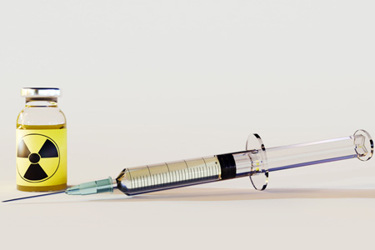Peeling Back The Layers Of Radiolabeled Peptide Production
A conversation with Randy Peterson, RadioMedix

To imagine what it takes to produce radiolabeled biologic therapeutics, start with the complexity of making radioactively inert drugs. Then, layer on extra containment measures to manufacture a product that begins losing potency from the moment it exists.
Radiopharmaceuticals began as diagnostic tools with the first one, a peptide, approved by the FDA in the late 1980s. More recently, as technology for targeting diseases matures, they have emerged as promising and powerful therapeutics. Beyond treatment, the so-called “theragnostic” approach blends therapy, monitoring, and diagnostics to treat and monitor cancer with a single dose.
RadioMedix, a clinical-phase company developing nuclear peptides and other radioactive modalities, has been refining its approach to radiolabeling at its central manufacturing facility in Humble, Texas, north of Houston.
The company licensed its first commercial phase diagnostic asset DetectNet to Curium, which serves as a diagnostic for neuroendocrine cancers. Last year, Sanofi licensed RadioMedix’s AlphaMedix candidate in a three-way collaboration with Orano Med, a French radioligand therapy developer.
AlphaMedix, now undergoing a Phase 3 trial, is a Pb212-based, targeted radioligand therapy for treating metastatic or inoperable neuroendocrine tumors.
Producing nuclear drugs requires a deep understanding of the modality of choice and how the mechanism of action — the radioactive isotope — behaves.
Amid the booming interest and increasing investment in radiopharmaceuticals, we asked RadioMedix Chief Operating Officer Randy Peterson, M.Sc., Ph.D., MBA, to help us begin peeling back the layers of complexity involved in making these drugs. Answers have been edited for clarity.
Can we start with environmental monitoring and PPE protocols? How do they compare to those needed, for example, when making non-radioactive drugs in aseptic environments?
Peterson: There are a lot of parallels between radioactive and regular pharma or biopharmaceutical manufacturing in terms of setting up the facility and abiding by regulatory frameworks to ensure the safety, integrity, and strength of the product.
But in radiopharmaceuticals — and this is something that is not greatly appreciated and can require a great deal of experience — there's an overlay of radiation safety and the containment of high-energy-yield work attached to the active pharmaceutical ingredient. The medical isotopes themselves all have differing physical properties, which make them attractive for implementation in precision oncology. But the consequence is additional investment to ensure the operators’ safety.
We're talking about hot cells, which are lead-lined containment units within an ISO environment. All the predicates to manufacture at a cGMP level exist in radiopharma, but in addition, you need these fairly robust containment workspaces within the ISO-rated areas to ensure the safety of the operators. And it doesn't stop there.
It could be the use of, depending on the radioisotope you're using, glove boxes or even manipulators.
How does that impact operations or trying to set up a radiopharma manufacturing facility from scratch? It really adds lead time because these things are all OEM, and they're bespoke to your particular manufacturing facility configuration. Currently in the industry, it’s anywhere from 18 months to 24 months to get a hot cell delivered to your site. And the manipulators themselves can sometimes be OEM as well.
These sorts of things are sometimes not appreciated by people who say, “Oh, I'm making a biopharmaceutical. Why don't I just jump into radio because I can just bolt on X, Y, Z medical isotope and be up and running?”
That's not the case. You really need a well-planned rollout of the manufacturing facility. And that's just for the hands-on manipulation of making a radiopharmaceutical.
On top of that, there's the environmental controls. There’s regular monitoring for particulate matter and the various micro assays to ensure sterility.
HVAC is the Achilles’ heel, if you will, of radiopharma because you need very sophisticated, very well-monitored HVAC systems, and that dovetails into very sophisticated building management systems to ensure that you are complying with all regulatory requirements for venting and for air circulation.
Is it difficult to make radiolabeled drugs in a central location? Is it better to have dispersed sites closer to the point of care?
Peterson: I think that's an ongoing debate in the sector. It hinges on your choice of isotope. As a colleague of mine says, “We're basically selling a melting ice cube.”
We're all focused on the quickest and most efficient timeline from manufacturer to the patient. So, certain isotopes lend themselves better to centralized manufacturing, and some, given their half-life, would follow a more decentralized path.
You could have regional manufacturing hubs and cover a certain area depending on the half-life of the isotope. Now — this is something that I feel goes a little bit under the radar — we calibrate the doses and account for decay.
We're a lead-centric company, and lead has a 10.6-hour half-life. If we were to manufacture in Houston to get it to a patient, we usually calibrate it to within one half-life, so the dose is just as effective as when it was first manufactured.
There’s a lot of debate in the industry. I think we're going to settle on both a centralized and decentralized model for manufacturing based on the isotope and the available technology.
For example, Telix, with their gallium PSMA Illuccix kit — that's what we in the industry call a shake-and-bake kit — potentiates a decentralized model. There are a number of gallium generators that would provide the API in conjunction with the kit to deliver the PET agent at radio-pharmacies globally.
In the future, I think we're going to see similar models for other isotopes — lead being the next one likely to be both centralized and decentralized.
Higher-activity amounts to support larger-phase trial manufacturing and commercialization would probably be centralized, given the activity needed to make the necessary doses. But a lead generator has a much lower bar of entry to use, and there are several lead generator companies in the space.
You have AdvanCell, ARTBIO, TAG1, and us — we’re making an announcement about our own lead generator — all these generators are meant to potentiate and facilitate greater traction of lead in these earlier stages.
How do you approach stability testing with an API that decays in real time?
Peterson: In a classical small molecule or even biologic, stability is much longer. Whereas in radiopharma, we only have to prove stability within the window in which the API decays.
That’s depending on the API, and that's built into the overall quality specifications scoped out during process development. It is an issue; the context is shorter, but the approach is similar to those in biopharma.
How do you balance the need for rapid on-demand production with a high cost of radioactive material handling and compliance?
This is where the rubber meets the road, in my opinion.
In our experience, it boils down to planning and execution. You need to lock up supply of the isotope first. Then, you need to lock up supply of the ligand, whether that’s a peptide, antibody fragment, or whatever the case may be. And then it comes down to the experience of the people making the drug.
Do they understand that they need to plan weeks in advance, to align internal resources and have the overall capacity to do everything from radiolabeling to release? There are a lot of parallels between radiopharmaceuticals and biopharmaceuticals, but the API or the source of the radioisotope is not commoditized at this point. Even if it was, it decays. It's a highly specialized manufacturing process input that has to be accounted for in your operational execution.
What are your thoughts on the future of radiolabeling therapeutics?
Peterson: I take it from two viewpoints.
There are technical and operational hurdles that we can clear that involve the efficiency of radiolabeling when it comes to isotope, chelator, and ligand. There's always a push to automate, to extract the human factor out of the process, and to standardize radiolabeling processes. We're seeing some fascinating and really great technology from providers like Trasis, which are addressing those technical issues.
Now, in terms of ligand optimization, I often say the low-hanging fruit has been picked. We are coming to the end of radiopharma 1.0.
What I’d like to see in radiopharma 2.0 is going to be, to my mind, two things.
New clinical targets are going to be validated. There are some fascinating ones at RadioMedix. We're working on areas of high unmet need, and we have some exciting programs to address that.
But there’s also the attenuation or the tuning of these ligands internally to reduce any aberrant toxicity, which has the industry’s attention right now. We also see enabling technologies that would take legacy molecules and help increase their residency and affinity for these tumors. Given the demonstrated efficacy of some of the marketed products, we're only delivering between 1% and, at the high end, 5% of an injected dose to the tumor, and it's still incredibly efficacious.
I see a hope for technologies that enable increased uptake and affinity to these tumors using legacy molecules, and I think that's going to be 2.0. There's a lot of cross-pollination between radiopharma ligand discovery and optimization and immuno-oncology fields as well. The jury is still out about using full-length monoclonal antibodies as ligands, given their long circulation time.
Our asset, AlphaMedix, a peptide drug that was licensed to Sanofi through our partnership with Orano Med, will be the first-in-class therapeutic for the treatment of neuroendocrine tumors.
Novartis cemented radiopharma as the fourth pillar in cancer treatment with Pluvicto. Lutathera will be another unicorn drug for Novartis following Pluvicto. I think we're still in early innings, but the use case has been proven, and the efficacy is fantastic.
 About The Expert:
About The Expert:
Randy Peterson is chief operating officer of RadioMedix. His experience includes the development and commercialization of biopharmaceutical, cell and gene, and radiopharmaceutical areas of precision oncology. He received his Ph.D. in neuroscience from McMaster University and his MBA from the Goodman School of Business.
